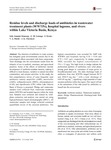Residue levels and discharge loads of antibiotics in wastewater treatment plants (WWTPs), hospital lagoons, and rivers within Lake Victoria Basin, Kenya

View/
Date
2015-12Author
Kimosop, Selly J.
Getenga, Z. M.
Orata, F.
Okello, V. A.
Cheruiyot, J. K.
Metadata
Show full item recordAbstract
The detection of antibiotics in water systems
has instigated great environmental concern due to the
toxicological effects associated with these compounds.
Their discharge into the environment results from the
ubiquity of use in medical, veterinary, and agricultural
practices. Some of the effects of antibiotics include
development of antibiotic-resistant bacteria, making it
difficult to treat diseases, variation in natural microbial
communities, and enzyme activities. In this study, the
first comprehensive survey of some frequently used
antibiotics namely ampicillin (AMP), amoxicillin
(AMX), sulfamethoxazole (SMX), chloramphenicol
(CAP), and ciprofloxacin (CPF) within Lake Victoria
Basin of Kenya is presented. Sludge and wastewater
samples were collected from wastewater treatment
plants (WWTPs) and hospital lagoons within the study
area. Samples were extracted and cleaned by solidphase
extraction, and analysis was carried out using
high-performance liquid chromatography (HPLC). All
wastewater samples and sludge collected contained
quantifiable levels of the selected antibiotics. The
highest concentrations were recorded for AMP with
WWTPs and hospitals having 0.36 ± 0.04 and
0.79 ± 0.07 μg/L, respectively. In sludge samples,
SMX recorded the highest concentrations of
276 ± 12 ng/g. The high levels in sludge indicate the
preferential partition of antibiotics onto solid phase,
posing great danger to consumers of crops grown in
biosolid-amended soils. The daily discharge loads of
antibiotics from nine WWTPs ranged between 80.75
and 3044.9 mg day− 1 with a total discharge of
6395.85 mg day−1, signifying a high potential of water
resource pollution within the region. This report will aid
in the assessment of the risks posed by antibiotics released
into the environment.
Keywords Antibiotic residues .Wastewater treatment
plants . Sludge . Pharmaceuticals . Discharge loads . Risk
assessment
